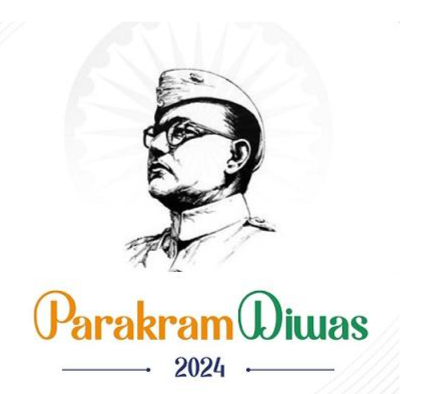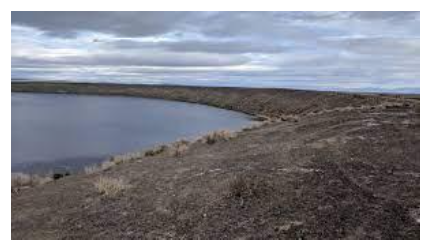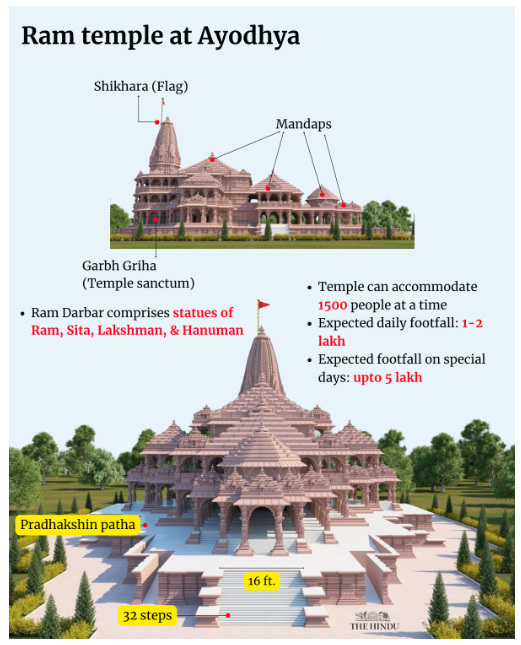Friday, 26th January 2024
Parakram Diwas 2024
In News: The Prime Minister of India recently took part in the Parakram Diwas celebrations at the Red Fort on January 23, 2024, commemorating the birth anniversary of Netaji Subhas Chandra Bose.

Parakram Diwas: Commemorating Netaji Subhas Chandra Bose's Birth Anniversary
- Initiation and Significance
- Established in 2021, Parakram Diwas is an annual celebration in India marking the birth anniversary of Netaji Subhas Chandra Bose.
- The term "Parakram" in Hindi translates to courage or valour, reflecting Netaji's strong and courageous spirit and the resilience of those who fought for India's freedom.
- Celebration Overview
- Various events and activities are organized to highlight the historical significance of Netaji's role in the freedom struggle.
- The Ministry of Culture collaborates with institutions like the Archaeological Survey of India, National School of Drama, Sahitya Akademi, and the National Archives of India for comprehensive celebrations.
- Activities delve into the profound legacy of Netaji Subhash Chandra Bose and the Azad Hind Fauj.
- Legacy Display: Netaji's 125th Birth Anniversary
- In 2022, a hologram near India Gate marked Netaji's 125th birth anniversary.
- The hologram, initially installed, was later replaced by a grand statue on September 8, 2022, near India Gate in New Delhi.
Subhash Chandra Bose Aapda Prabandhan Puraskar: Recognizing Excellence in Disaster Management
- Institution of the Award
- The Subhash Chandra Bose Aapda Prabandhan Puraskaar (SCBAPP) was instituted by the Government of India to recognize outstanding work in disaster management.
- Administration
- Administered by the National Disaster Management Authority (NDMA), established under the Ministry of Home Affairs.
- Award Details
- Announced annually on Netaji Subhash Chandra Bose's birth anniversary on January 23.
- Includes a certificate and a cash award of Rs. 51 lakhs for an institution and Rs. 5 lakhs for an individual.
- The cash prize for institutions is meant for Disaster Management related activities.
- Eligibility Criteria
- Open to Indian nationals and institutions engaged in various aspects of disaster management.
- Areas of work include Prevention, Mitigation, Preparedness, Rescue, Response, Relief, Rehabilitation, Research, Innovation, or early warning in India.
- SCBAPP 2024: Recognizing Outstanding Contributions
- The 60 Parachute Field Hospital, Uttar Pradesh, is the recipient of the SCBAPP-2024 for its exceptional work in disaster management.
- Notable contributions include providing medical assistance during events like the Uttarakhand floods (2013), Nepal Earthquake (2015), and the Turkey and Syria earthquake (2023).
|
UPSC Previous Year Questions Prelims (2021) Q. In the context of Colonial India, Shah Nawaz Khan, Prem Kumar Sehgal and Gurbaksh Singh Dhillon are remembered as (a) leaders of Swadeshi and Boycott Movement Ans: (d)
Prelims (2018) Q2. During the Indian Freedom Struggle, who of the following raised an army called ‘Free Indian Legion’? (a) Lala Hardayal Ans: (c)
Mains (2016) Q. Highlight the difference in the approach of Subhash Chandra Bose and Mahatma Gandhi in the struggle for freedom. |
Source: HT
Cancellation of FCRA Registration of NGOs
In News: The revocation of FCRA registrations for two major NGOs, the Centre for Policy Research (CPR) and World Vision India (WVI), has triggered discussions on India's regulatory framework for foreign contributions.
Reasons Behind CPR and WVI Registration Cancellation
- Accusations by the Ministry of Home Affairs (MHA)
- The MHA accused the Centre for Policy Research (CPR) of redirecting foreign donations to support protests and legal challenges against development projects.
- Allegations include the misuse of funds to impact India's economic interests.
- Specific Allegations Against CPR
- CPR is accused of violating FCRA norms by producing current affairs programs, such as a report on air pollution, using foreign funds.
- The MHA claims that publishing such programs contradicts Section 3 of the FCRA.
- World Vision India's Registration Revocation
- World Vision India (WVI) faced FCRA violations from 2012-13 to 2020-21.
- WVI, a top recipient of foreign donations among FCRA-registered NGOs since 1986, was subject to registration cancellation.
Understanding the Foreign Contribution Regulation Act (FCRA)
- Introduction to FCRA
- Enacted in 1976 during the Emergency period due to concerns about foreign interference in India's affairs through financial support to independent organizations.
- Aims to regulate foreign donations to prevent adverse impacts on internal security, ensuring alignment with sovereign democratic principles.
- Evolution of FCRA
- 2010 Amendment: Streamlined regulations, forbidding foreign contributions for activities harmful to national interests.
- 2020 Amendment: Introduced Aadhaar number requirement for key functionaries, designated FCRA bank accounts, complete ban on domestic transfer of foreign funds, and reduced administrative expense limit from 50% to 20%.
- Applicability and Renewal
- FCRA mandates registration for all associations, groups, and NGOs intending to receive foreign donations.
- Initially valid for 5 years, renewable upon compliance with prescribed norms.
- Purposes of Foreign Contributions
- Registered associations can receive foreign contributions for social, educational, religious, economic, and cultural purposes.
- Monitoring Authority
- Ministry of Home Affairs oversees FCRA compliance.
- In 2015, MHA mandated NGOs to operate accounts in banks with core banking facilities for real-time security access.
- In 2023, rules were amended, requiring FCRA-registered NGOs to disclose assets created using foreign funds in their annual returns.
|
UPSC Previous Year Questions Mains (2021) Q. Can Civil Society and Non-Governmental Organisations present an alternative model of public service delivery to benefit the common citizen? Discuss the challenges of this alternative model. |
Source: TH
Amrit Dharohar Capacity Building Scheme
In News: The Central government is leading a substantial revolution in the domain of wetland tourism through the 'Amrit Dharohar Capacity Building Scheme.'
Amrit Dharohar Capacity Building Scheme: Fostering Sustainable Wetland Tourism
- Collaborative Initiative
- The 'Amrit Dharohar Capacity Building Scheme' is a joint effort by the Ministry of Tourism and the Ministry of Environment, Forest, and Climate Change.
- Implementation Period and Objectives
- Spanning the next three years from 2023, the scheme aims to promote the optimal utilization of wetlands.
- It targets the enhancement of biodiversity, carbon stock, eco-tourism opportunities, and income generation for local communities.
- Strategic Focus
- The primary emphasis is on transitioning from high-volume tourism to high-value nature tourism, particularly at ecologically sensitive wetlands.
- Aim of the Scheme
- The primary goal is to boost livelihood opportunities for local communities by harnessing the nature-tourism potential of Ramsar Sites across the country.
- Collaborative Implementation
- The scheme operates in convergence with various Central Government ministries and agencies, State wetland authorities, and a network of formal and informal institutions and individuals.
- Pilot Projects and Skill Development
- Out of the 16 identified Ramsar sites, five serve as pilot projects under the scheme.
- Pilot sites include Sultanpur National Park (Haryana), Bhitarkanika Mangroves (Odisha), Chilika Lake (Odisha), Sirpur (Madhya Pradesh), and Yashwant Sagar (Madhya Pradesh).
- Training programs under the Alternative Livelihood Programme (ALP) and Paryatan Navik Certificate focus on skill development, with a 30 hours/15 days training program for participants.
Ramsar Sites: Internationally Recognized Wetlands
- Definition and Designation
- Ramsar sites are wetlands internationally recognized for their importance under a treaty signed in February 1971 in Ramsar, Iran, under UNESCO auspices.
- Objectives of Ramsar Convention
- Ramsar facilitates national action and international cooperation for wetland conservation and wise sustainable use of resources.
- India's Contribution
- India boasts 75 Ramsar sites, reflecting its commitment to preserving and sustainably managing wetlands.
|
UPSC Previous Year Questions Prelims (2022) Q1. "If rainforests and tropical forests are the lungs of the Earth, then surely wetlands function as its kidneys." Which one of the following functions of wetlands best reflects the above statement? (a) The water cycle in wetlands involves surface runoff subsoil percolation and evaporation. (b) Algae form the nutrient base upon which fish, crustaceans, molluscs, birds, reptiles and mammals thrive. (c) Wetlands play vital role in maintaining sedimentation balance and soil stabilization. (d) Aquatic plants absorb heavy metals and excess nutrients. Ans: (c) Prelims (2019) Q2. Consider the following statements:
Which of the statements given above is/are correct? (a) 1 and 2 only Ans: (c) |
Source: TH
Arambai Tenggol: Who are the Radical Meitei Group?
In News: Meitei MLAs, along with Lok Sabha and Rajya Sabha MPs from Manipur's valley regions, convened at Kangla Fort in Imphal in response to summons from the radical group Arambai Tenggol.
Arambai Tenggol Group: Unraveling a Radical Transformation
- Formation and Evolution
- Originating in 2020 as a cultural outfit, Arambai Tenggol swiftly transitioned into a radical organization, becoming one of the two hardline Meitei groups alongside Meitei Leepun.
- Suspected involvement in the Meitei-Kuki clashes of May 2023, where both groups armed themselves, experiencing a rapid surge in membership during the conflict.
- Accusations and Involvement
- Accused by Kuki groups and security establishments of playing a significant role in the violent clashes.
- Allegations of targeting Naga community members and involvement in a gunfight with Assam Rifles just before the Union Home Minister's visit to Manipur in June 2023.
Arambai Tenggol's Political 'Summon': Demands and Actions**
- Meeting Objectives
- The meeting aimed to discuss Arambai Tenggol's demands, which included delisting Kukis from the Scheduled Tribes list, deportation of refugees to Mizoram camps, border fencing, replacing Assam Rifles with other paramilitary forces, and revoking the Suspension of Operations (SoO) agreement.
- Leadership's Statements
- Arambai Tenggol leader Korounganba Khuman addressed the representatives, claiming they were made to sign a set of demands to pressure the Central government for action.
- This highlighted the group's strength and legitimacy, evolving from its initial shadowy presence.
Manipuri Demographics: A Mosaic of Communities
- Geographical Overview
- Manipur's landscape is akin to a football stadium, with the Imphal Valley as the central playfield and surrounding hills as galleries.
- The valley, covering 10% of Manipur's landmass, is predominantly occupied by non-tribal Meitei, holding 40 out of 60 MLAs.
- The hills, comprising 90% of the area, house over 35% recognized tribes, contributing only 20 MLAs to the Assembly.
Roots of Violence in Manipur: Unpacking Recent Protests
- Triggering Event
- Recent protests stem from Manipur HC's directive to the state to pursue a decade-old recommendation, granting Scheduled Tribe (ST) status to the non-tribal Meitei community.
- The court order intensifies historical tensions between the valley-dwelling Meitei community and the state's hill tribes, particularly the Kukis.
Source: IE
Exercise Desert Knight
In News: In a recent collaboration, the Indian Air Force (IAF) partnered with the French Air and Space Force (FASF) and the United Arab Emirates (UAE) Air Force in Exercise Desert Knight, demonstrating cooperative air operations and fostering diplomatic bonds.
Exercise Desert Knight: Trilateral Military Collaboration
- Collaborative Endeavor
- Exercise Desert Knight represents a joint military drill involving India, France, and the United Arab Emirates (UAE).
- Operational Setting
- Conducted over the Arabian Sea, the Indian Air Force (IAF) operated from bases within India.
- Primary Objective
- The exercise aimed at enhancing cooperation and interoperability among the three participating air forces.
Source: TOI
Rabbit r1
In News: Rabbit Inc. has created a platform backed by an artificial intelligence model that can mimic and perform human smartphone actions upon command, thereby augmenting the capabilities of current voice assistants.

Rabbit Inc.'s r1: Revolutionizing Human-to-Machine Interaction
- Introduction of r1
- The r1, Rabbit Inc.'s inaugural device, is a compact standalone gadget designed for natural language-driven task completion.
- Innovative Technology
- Powered by a large action model (LAM) AI within the Rabbit OS, it embraces neuro-symbolic programming for direct learning from user interactions and task execution.
- Unlike traditional methods, it avoids translating text-based requests into APIs, fostering a more nuanced human-to-machine interaction.
- Focus on Practical Tasks
- The device concentrates on routine and minimalist tasks, utilizing the biased-for-action AI model to surpass the limitations of conventional chatbots.
- Advantages Over Large Language Models
- The r1 reduces reliance on text-based AI models, such as large language models, that heavily depend on annotated data.
- This approach enables the device to perform actionable tasks beyond generating plans.
- Versatility in Task Management*
- Capable of handling various tasks, from arranging Uber rides to organizing complete vacations, including flight and hotel bookings.
Source: BI
Grantha Script
In News: Archaeologists have recently unearthed two stone inscriptions, one in 'Grantham' and the other in Tamil, dating back to the 11th and 16th centuries, respectively, in the vicinity of Pazhnchervazhi village near Kangayam.

About Grantha Script
- Grantha Script Overview
- Grantha is a historical script used for writing Sanskrit, prevalent in South East Asia and greater Tamil Nadu.
- The name "Grantha" in Sanskrit originally means 'a literary work,' and the script used for Sanskrit works adopted the same name.
- Geographical Usage and Evolution
- Grantha was widely used in South India, and when Malayalam began borrowing from Sanskrit, Grantha was adopted for writing Malayalam, known as Arya Ezhuthu.
- Both Grantha and Tamil scripts share similarities and evolved from Brahmi script.
- Development Phases
- Grantha script in Tamil Nadu evolved through four periods: archaic and ornamental, transitional, medieval, and modern.
- The archaic variety is called Pallava Grantha, seen in inscriptions like Mahendravarman's Tiruchirappalli rock-cut cave and Narasimhan's Mamallapuram.
- Transitional Period (650 CE - 950 CE)
- Grantha inscriptions during this period include later Pallava examples like Nandivarman's Kasakudi and Udayendram plates, as well as Pandyan Nedunjadaiyan's Anaimalai inscriptions.
- Medieval Period (950 CE - 1250 CE)
- The medieval Grantha script is exemplified by inscriptions of the imperial Cholas of Thanjavur.
- Modern Period (Post-1250 CE)
- The modern variety of Grantha script belongs to later Pandya and Vijayanagar periods.
- It remained popular in Tamil Nadu until the early 20th century.
- Impact of Printing Technology
- With the advent of printing machines, many Sanskrit books transcribed from palm leaves in Grantha script were printed.
- Decline After Independence
- Post-Independence, the popularity of Hindi in Devanagari script influenced printing practices, leading to a decline in the usage of Grantha script.
- Grantha went out of vogue as Hindi gained prominence in printed materials.
Source: TH
Section 420 of IPC
In News: The Supreme Court has emphasized that in prosecuting someone under IPC Section 420 for cheating, it is crucial to determine if the deceptive act involved inducing the complainant to part with their property.
- Introduction to IPC Section 420
- IPC Section 420 addresses the offense of cheating and dishonestly inducing individuals to part with property or manipulate valuable securities.
- Cheating Defined in IPC Section 415
- IPC Section 415 provides the definition of cheating, characterizing it as a deceptive act conducted to gain an advantage.
- Scope of IPC Section 420
- IPC 420 represents a severe form of cheating involving inducement leading to the delivery of property or valuable securities.
- It is applicable in cases where cheating or inducement results in the destruction of property.
- Penalties Under IPC Section 420
- A person found guilty under Section 420 may face imprisonment of up to seven years and be subject to a fine.
- The offense is both cognizable and non-bailable.
- Key Elements of IPC Section 420 Offense
- False Representation: The accused made a false representation.
- Knowledge of Falseness: The accused knew the representation was false at the time of making it.
- Dishonest Intent: The false representation was made with the dishonest intention of deceiving the other person.
- Inducement: The accused induced the person to deliver property or perform an action they would not have otherwise done.
Source: LL
Soda Lake
In News: Researchers have found that a shallow "soda lake" in western Canada bears similarities to Darwin's concept of "warm little ponds," suggesting it could be a suitable environment for the origins of life on early Earth.

- Overview of Soda Lakes
- Soda Lakes typically exhibit a pH range of 9 to 11.
- High carbonate concentration, particularly sodium carbonate, contributes to the alkalinity, and they may contain elevated levels of sodium chloride and other salts, making them saline or hypersaline.
- Productivity and Environment
- Soda Lakes are highly productive ecosystems, surpassing freshwater lakes.
- They naturally occur in arid and semi-arid regions.
- Geology and Formation
- Geological, climatic, and geographic conditions are crucial for a lake to become alkaline.
- Topography limiting water outflow leads to the formation of an endorheic basin.
- Evaporation in a suitable climate, like a desert climate, raises the water's pH.
- Factors Influencing pH
- The dissolution rate of carbonate salt in lake water depends on the surrounding ecology.
- The relative absence of magnesium and calcium is vital for soda lake formation, as their presence can neutralize the water's pH.
- Biodiversity in Soda Lakes
- Prokaryotes, such as bacteria and archaea, dominate in lakes with higher alkalinity.
- Multicellular organisms like brine shrimp and fish are abundant in most soda lakes.
- Examples of Soda Lakes
- Africa and Asia, with vast desert conditions, host numerous soda lakes.
- Eastern Africa, especially Kenya, Tanzania, and Ethiopia, has a significant number, with Lake Natron in Tanzania being notable.
- India and China lead in the number of soda lakes in Asia, including Lake Van, Tso Kar Salt Lake, Pangong Salt Lake, and Lake Zabuye.
Source: PO
Smart Rings
In News: Smart rings are compact yet powerful wearables that excel in health tracking and other functionalities, all packed into a discreet and unobtrusive device.

- Introduction to Smart Rings
- Smart rings, compact yet powerful, incorporate advanced technology within a small ring-sized device.
- Similar to larger smartwatches, they offer diverse functionalities, including health monitoring and device control.
- Health Monitoring Capabilities
- Packed with advanced sensors, smart rings track various health metrics such as heart rate, blood oxygen levels, sleep quality, steps, and stress levels.
- Users can access and analyze this data through a connected smartphone app, facilitating progress tracking towards health goals.
- Convenience Features
- Beyond health tracking, smart rings enhance convenience with features like gesture controls and haptic feedback for notifications.
- Simple gestures, such as a flick of the finger, enable actions like adjusting smart lights or managing playlists. Notifications are subtly delivered through a buzz on the finger.
- Functionalities of Smart Rings
- Constant health monitoring stands out as a primary feature, requiring minimal user intervention.
- Personalized breathing exercises and guided meditations contribute to mood improvement.
- Contactless payment capabilities add a convenient aspect to smart rings.
- Gesture Recognition and Control
- Smart rings commonly include gesture recognition, allowing users to perform actions like twisting or tapping to control various devices.
- This functionality extends to turning off lights, adjusting thermostats, unlocking doors, and more.
- Security and Access
- Smart rings serve as access badges, providing secure and convenient unlocking of doors and gates with a simple touch.
Source: IE
India’s Semiconductor Industry
In News: A recent article explores how a revamped Design-Linked Incentive (DLI) scheme under the India Semiconductor Mission (ISM) could strengthen India's competitive edge and enhance its engagement across different phases of the semiconductor global value chain.

Overview of the India Semiconductor Mission (ISM)
- Launched in 2021 with a financial outlay of Rs. 76,000 crore under the Ministry of Electronics and IT.
- Aims to develop sustainable semiconductor and display ecosystems in India.
- Encompasses various schemes to support semiconductor, display manufacturing, and design.
Components of the ISM
- Semiconductor Fabs
- Scheme for setting up Semiconductor Fabs in India.
- Display Fabs
- Scheme for setting up Display Fabs in India.
- Compound Semiconductors
- Scheme for setting up Compound Semiconductors, Silicon Photonics, Sensors Fab, and Semiconductor Assembly, Testing, Marking, and Packaging (ATMP) facilities.
- Design Linked Incentive (DLI) Schemes
- Focuses on providing financial incentives and design infrastructure support for semiconductor design.
- Implemented by C-DAC (Centre for Development of Advanced Computing).
Components of the DLI Scheme
- Chip Design Infrastructure Support
- Creation of India Chip Centre by C-DAC.
- State-of-the-art design infrastructure, EDA Tools, IP Cores, and support for MPW.
- Product Design Linked Incentive
- Reimbursement of up to 50% of eligible expenditure, up to Rs. 15 Crore per application.
- Fiscal support for approved semiconductor design applicants.
- Deployment Linked Incentive
- Incentive of 6% to 4% of net sales turnover over 5 years, up to Rs. 30 Crore per application.
- Provided to approved applicants deploying semiconductor design in electronic products.
Vision and Significance of ISM
- Vision: Build a vibrant semiconductor and display design ecosystem for India to become a global hub for electronics manufacturing and design.
- Significance: Organizes efforts for the promotion of the semiconductor and display industry, formulates long-term strategies, and facilitates collaborations for research and skill development.
Global and Indian Semiconductor Market Scenario
- Global Scenario
- Concentrated in Taiwan, South Korea, and the U.S.
- USD 500-600 billion industry catering to a USD 3 trillion global electronics industry.
- Indian Scenario
- Valued at USD 23.2 billion, projected to reach USD 150 billion by 2029.
- Initiatives like ISM and SPECS to support semiconductor R&D and manufacturing in India.
Challenges in the Semiconductor Industry in India
- Data Latency
- Challenges in managing varied co-products and data latency.
- Customer-Specific Needs
- Varied needs based on customer demands.
- Front-end (FE) Built Output
- Complexity in supply chain due to additional manufacturing steps.
- Back-End (BE) Cycle Times
- Quicker BE cycle times compared to FE.
- Supply Chain Visibility
- Challenges in end-to-end supply chain visibility.
- Fab Setup Costs
- Extremely expensive setup costs for semiconductor fabs.
Issues in DLI Scheme Implementation
- Lacklustre Uptake
- Limited adoption due to ownership restrictions and funding landscape.
- Competitive Industry
- Tough competition with established players like the U.S., South Korea, Taiwan, and China.
- Intellectual Property Challenges
- Access to intellectual property and licensing agreements can be hurdles.
- Global Investments
- Gaining a competitive edge and attracting global investments pose challenges.
Overhauling the ISM and DLI Scheme
- Integrating Goals
- Integrate strategic goals involving strategic sectors, global value chain integration, and leveraging existing design capabilities.
- Maximizing Investment Benefits
- Prioritize investments to maximize benefits, focusing on the less capital-intensive design ecosystem.
- Delinking Ownership
- Delink ownership restrictions from semiconductor design development for start-ups.
- Attract more global exposure and financial stability.
- Broadening DLI Scheme Focus
- Shift focus to cultivate design capabilities for various chips.
- Increase financial support for a broader impact.
- Capable Institution for Implementation
- Establish a capable institution to lead policy implementation.
- Tolerate a certain failure rate and treat start-ups as exploratory risk-taking entities.
Utilizing Existing Facilities and Collaboration
- Utilize public sector enterprises for semiconductor fab foundry setup.
- Explore collaboration opportunities with countries like the U.S., Japan, Taiwan, South Korea, etc.
Conclusion
- The DLI scheme needs a shift in focus towards cultivating semiconductor design capabilities in India.
- Revisions should include delinking ownership from development, enhancing financial support, and reconsidering the role of the nodal agency.
- A recalibrated policy, guided by a capable institution, can establish India's foothold in the high-tech semiconductor sector.
|
UPSC Previous Year Questions Prelims (2008) Q. Which one of the following laser types is used in a laser printer? (a) Dye laser Ans: (c) Prelims (2018) Q. With reference to solar power production in India, consider the following statements:
Which of the statements given above is/are correct? (a) 1 only Ans: (d) |
Source: TH
Share the article
Edukemy’s Current Affairs Quiz is published with multiple choice questions for UPSC exams
MCQ
Get Latest Updates on Offers, Event dates, and free Mentorship sessions.

Get in touch with our Expert Academic Counsellors 👋
FAQs
UPSC Daily Current Affairs focuses on learning current events on a daily basis. An aspirant needs to study regular and updated information about current events, news, and relevant topics that are important for UPSC aspirants. It covers national and international affairs, government policies, socio-economic issues, science and technology advancements, and more.
UPSC Daily Current Affairs provides aspirants with a concise and comprehensive overview of the latest happenings and developments across various fields. It helps aspirants stay updated with current affairs and provides them with valuable insights and analysis, which are essential for answering questions in the UPSC examinations. It enhances their knowledge, analytical skills, and ability to connect current affairs with the UPSC syllabus.
UPSC Daily Current Affairs covers a wide range of topics, including politics, economics, science and technology, environment, social issues, governance, international relations, and more. It offers news summaries, in-depth analyses, editorials, opinion pieces, and relevant study materials. It also provides practice questions and quizzes to help aspirants test their understanding of current affairs.
Edukemy's UPSC Daily Current Affairs can be accessed through:
- UPSC Daily Current Affairs can be accessed through Current Affairs tab at the top of the Main Page of Edukemy.
- Edukemy Mobile app: The Daily Current Affairs can also be access through Edukemy Mobile App.
- Social media: Follow Edukemy’s official social media accounts or pages that provide UPSC Daily Current Affairs updates, including Facebook, Twitter, or Telegram channels.



